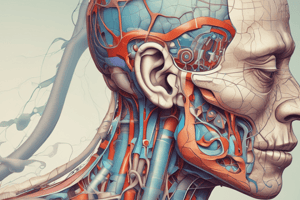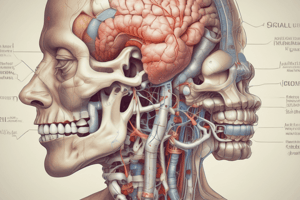Podcast
Questions and Answers
What is the most common cause of acute sinusitis?
What is the most common cause of acute sinusitis?
- Allergic reaction
- Trauma to the face
- Bacterial infection
- Viral infection (correct)
What is a common symptom of sinusitis?
What is a common symptom of sinusitis?
- Abdominal pain
- Sore throat
- Nasal congestion (correct)
- Difficulty breathing
When is it likely that viral sinusitis has become bacterial?
When is it likely that viral sinusitis has become bacterial?
- If symptoms occur only at night
- If symptoms last for 5 days or less
- If symptoms exceed 10 days or worsen (correct)
- If symptoms occur seasonally
What is a common treatment for sinusitis?
What is a common treatment for sinusitis?
What is a common complication of sinusitis?
What is a common complication of sinusitis?
How do nerve impulses travel to muscle fibers in the diaphragm?
How do nerve impulses travel to muscle fibers in the diaphragm?
What happens as the dome-shaped diaphragm moves downward?
What happens as the dome-shaped diaphragm moves downward?
True or False: Atmospheric pressure forces air into the respiratory tract through the air passages.
True or False: Atmospheric pressure forces air into the respiratory tract through the air passages.
What fills with air when the lungs fill with air?
What fills with air when the lungs fill with air?
What happens when the diaphragm and external intercostal muscles relax?
What happens when the diaphragm and external intercostal muscles relax?
What causes the collapse of alveolar walls during expiration?
What causes the collapse of alveolar walls during expiration?
What increases the intraalveolar pressure during expiration?
What increases the intraalveolar pressure during expiration?
How is air expelled from the lungs?
How is air expelled from the lungs?
Flashcards are hidden until you start studying
Study Notes
Sinusitis
- Inflammation of the membranes lining the sinuses, can be acute or chronic
Aetiology
- Acute sinusitis is mostly caused by viral infections, often following a common cold
- Bacterial sinusitis often develops after a viral sinusitis
- If symptoms persist or worsen after 10 days, viral sinusitis may have become bacterial
Presentation
- Symptoms include headache, facial pain, tooth pain, nasal congestion, fever, and postnasal discharge (PND)
- May be accompanied by pharyngitis and cough
Management
- Treatment options include nasal corticosteroids and decongestants sprays
- Analgesics may be prescribed to manage pain
- Antibiotics may be used to treat bacterial infections
Inspiration Mechanism
- Nerve impulses travel through phrenic nerves to muscle fibres in the diaphragm, causing them to contract
- The contraction of the diaphragm causes it to move downward, expanding the thoracic cavity
- As the thoracic cavity expands, the intra-alveolar pressure decreases
- The decrease in intra-alveolar pressure creates a pressure gradient, allowing atmospheric pressure to push air into the respiratory tract through the air passages
- The lungs fill with air as a result of the increased pressure difference
Expiration Process
- Diaphragm and external intercostal muscles relax, marking the start of expiration
- Elastic tissues of lungs and thoracic cage, stretched during inspiration, suddenly recoil during expiration
- Recoil of elastic tissues causes surface tension to collapse alveolar walls
- Recoil of tissues around lungs increases intraalveolar pressure
- Increased intraalveolar pressure squeezes air out of the lungs
Studying That Suits You
Use AI to generate personalized quizzes and flashcards to suit your learning preferences.




